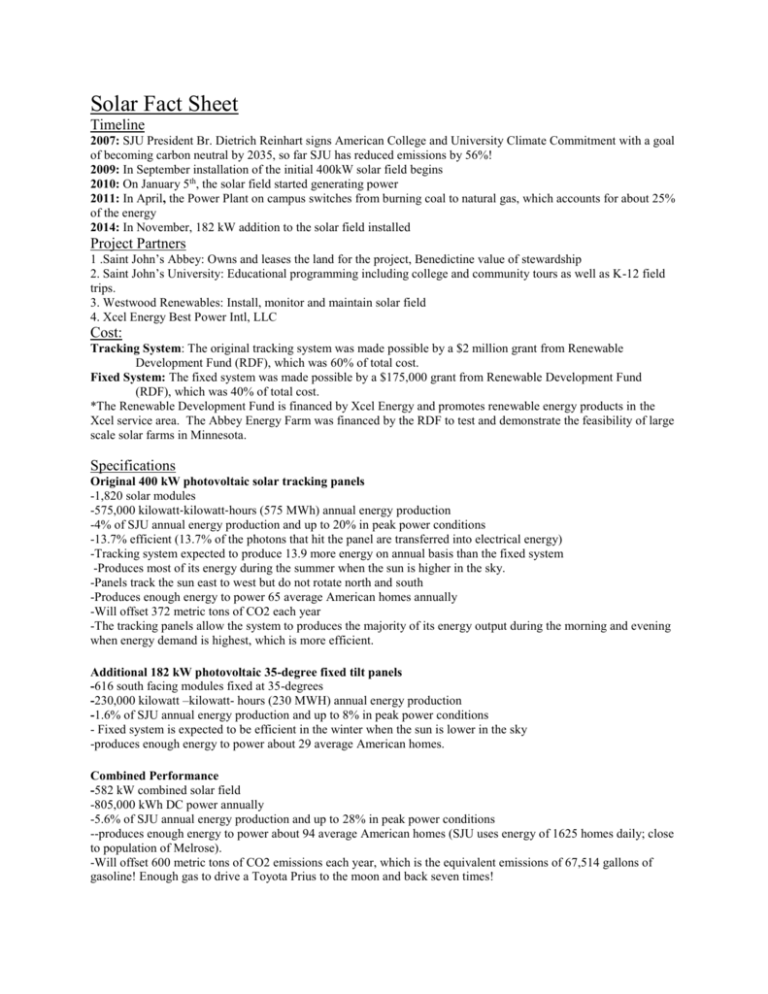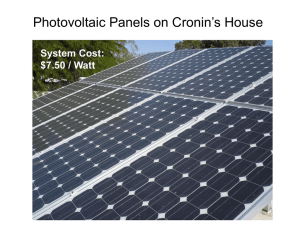Solar Fact Sheet - College of Saint Benedict & Saint John`s University
advertisement

Solar Fact Sheet Timeline 2007: SJU President Br. Dietrich Reinhart signs American College and University Climate Commitment with a goal of becoming carbon neutral by 2035, so far SJU has reduced emissions by 56%! 2009: In September installation of the initial 400kW solar field begins 2010: On January 5th, the solar field started generating power 2011: In April, the Power Plant on campus switches from burning coal to natural gas, which accounts for about 25% of the energy 2014: In November, 182 kW addition to the solar field installed Project Partners 1 .Saint John’s Abbey: Owns and leases the land for the project, Benedictine value of stewardship 2. Saint John’s University: Educational programming including college and community tours as well as K-12 field trips. 3. Westwood Renewables: Install, monitor and maintain solar field 4. Xcel Energy Best Power Intl, LLC Cost: Tracking System: The original tracking system was made possible by a $2 million grant from Renewable Development Fund (RDF), which was 60% of total cost. Fixed System: The fixed system was made possible by a $175,000 grant from Renewable Development Fund (RDF), which was 40% of total cost. *The Renewable Development Fund is financed by Xcel Energy and promotes renewable energy products in the Xcel service area. The Abbey Energy Farm was financed by the RDF to test and demonstrate the feasibility of large scale solar farms in Minnesota. Specifications Original 400 kW photovoltaic solar tracking panels -1,820 solar modules -575,000 kilowatt‐kilowatt‐hours (575 MWh) annual energy production -4% of SJU annual energy production and up to 20% in peak power conditions -13.7% efficient (13.7% of the photons that hit the panel are transferred into electrical energy) -Tracking system expected to produce 13.9 more energy on annual basis than the fixed system -Produces most of its energy during the summer when the sun is higher in the sky. -Panels track the sun east to west but do not rotate north and south -Produces enough energy to power 65 average American homes annually -Will offset 372 metric tons of CO2 each year -The tracking panels allow the system to produces the majority of its energy output during the morning and evening when energy demand is highest, which is more efficient. Additional 182 kW photovoltaic 35-degree fixed tilt panels -616 south facing modules fixed at 35-degrees -230,000 kilowatt –kilowatt- hours (230 MWH) annual energy production -1.6% of SJU annual energy production and up to 8% in peak power conditions - Fixed system is expected to be efficient in the winter when the sun is lower in the sky -produces enough energy to power about 29 average American homes. Combined Performance -582 kW combined solar field -805,000 kWh DC power annually -5.6% of SJU annual energy production and up to 28% in peak power conditions --produces enough energy to power about 94 average American homes (SJU uses energy of 1625 homes daily; close to population of Melrose). -Will offset 600 metric tons of CO2 emissions each year, which is the equivalent emissions of 67,514 gallons of gasoline! Enough gas to drive a Toyota Prius to the moon and back seven times! Benefits of Solar -With the exception of a small motor in the tracking panels, solar panels have very few moving parts and thus require less maintenance that other forms of renewable energy like windmills. -Most solar panels have a 30+ year lifespan and are quite durable (after 25 years operate at 80% of initial capacity) -Minnesota’s cool and snowy climate actually helps the panels by keeping them clean and cool. Cool temperatures keep panels from overheating and provide greater efficiency. -tax incentives for renewable energy Downsides of Solar -Original panels and installation can be expensive -The panels are durable, but can break due to storms, wind or even rocks from a lawn mower. -It is hard to store solar energy to use when the sun is not shining Solar in Minnesota -Minnesota is one of the top ten states in the Nation for solar power based on subsidies and solar insolation. Just as good as Miami Florida! -Germany is even further North than Minnesota and is the global leader in Solar producing 3x more solar energy than the U.S. (as of 2014) -Not as variable as wind energy -More energy in summer (longer days); in winter, cold temps = increased production/voltage and efficiency. How it works The Sun: energy in the form of heat and light: 93 million miles away. Every minute, enough energy reaches Earth to meet our worldwide energy demands for a whole year Active vs Passive Solar: Photovoltaic (PC) to transfer energy from Photons electrons Array: total collection of panels Module: panel of cells housed in single frame. First wired in series (called a string), then parallel Solar Cell: basic building block made up of two layers: silicon/phosphorous (5e – to spare) and boron+ (needs 1e-). Photon strikes silicon/phosphorous layer and excites electrons, electrons are channeled into wires where they become current. Eventually, the transfer will run out (efficiency is lost over time: in 25 years will be 80% efficient) Inverter: DC (direct current) to AC (alternating current) so it can be used in grid and homes for appliances, lighting heating, cooling, etc. Monitor: measure performance, production, demand (load). Real-time data is available on website Storage: Utility lines (could also use battery, depending on scale). If we make more than we use, others connected to the grid use it locally. Weather system and tracking -Weather Station measures humidity, wind speed, temperature etc. (If there is hail the trackers will store vertical, if there is extra strong winds the trackers will store horizontally) -Trackers follow the sun east to west using a GPS and a computer program, but do not tilt north and south making them less efficient in the winter when the sun is low in the sky. The motor is smaller than a standard blender motor. Future -More Solar! Wind Energy is not a very viable option here because all the trees break the wind speed.







